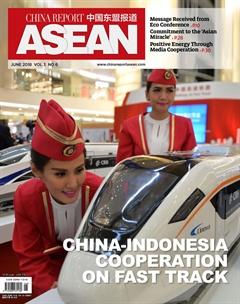ASEAN Journalists Explore China’s Coast
By Zhang Hongrui
This year marks the 15th anniversary of the China-ASEAN strategic partnership, the 40th anniversary of Chinas reform and opening-up and the fifth anniversary of the Belt and Road Initiative. It is also the China-ASEAN Year of Innovation.
Also in this important year, the China-ASEAN Media Journey on the 21st Century Maritime Silk Road 2018, jointly sponsored by ASEAN-China Center (ACC) and China International Publishing Group (CIPG) and organized by China Report Press, ventured down Chinas eastern coast from May 3 to 11.
A total of 23 journalists from 18 mainstream ASEAN media outlets traveled to Shanghai Municipality, Jiaxing, Shaoxing and Hangzhou cities in Zhejiang Province and Wuxi City in Jiangsu Province, where they visited more than 20 enterprises and institutes including China (Shanghai) Pilot Free Trade Zone, Alibaba Group and HOdo Group. Along the journey, journalists witnessed Chinas achievements over the last 40 years of reform and opening-up. They also gained an understanding of the fruits of China-ASEAN cooperation in economics and trade, investment and information, catching a glimpse of the broad scope for bilateral cooperation.
Seeing the Unexpected
“I have witnessed the rapid development of China with my own eyes,” declared Li Li Kwing, a journalist with Myanmar Radio and TV. “I had heard about Chinas development, but seeing is believing. My Chinese teacher used to tell us about Shanghai. He said that the buildings in the city are so tall that your hat will fall to the ground if you try to look to the top. I thought he was exaggerating. Now I believe him.”
Kwing believes that Chinas development stage today is in store for Myanmars future. Myanmar has much to learn from China. She hopes that China will provide Myanmar with more assistance in policy formulation, science and technology, strategic management, urban planning and other areas to help the country find its own path to success.
Myint Zaw Aung, chief editor of 7 Day Daily from Myanmar, echoed Kwings sentiments. “This is my first visit to China,” said Aung, “Its so amazing, absolutely beyond my imagination.” He had heard a lot about China and gained some understanding of China through the internet, books and magazines, so the most unexpected part of the journey was soaking up the beauty of Chinese cities, the advanced transportation and the progress in science of technology. He marveled at what he saw.
Aung told our reporter that many people in Myanmar are still grappling with poverty. He wants to share Chinas experiences and mode of development with Myanmar to help its development.
Patithin Phetmeuangphuan is a journalist with Vientiane Times of Lao PDR. He suggested more ASEAN journalists visit China to see for themselves the development speed of China today and share information about China with people in their respective home countries through objective and authentic reporting.
Opportunities on Maritime Silk Road
In recent years, China and ASEAN countries have become the closest trading partners in the region. Since 2009, China has been ASEANs largest trading partner for nine consecutive years, while ASEAN has been Chinas third largest trading partner, third largest export market and second largest source of imports for seven consecutive years. The total volume of imports and exports between China and ASEAN exceeded US$500 billion in 2017, a 65-fold increase over the bilateral trade volume of US$7.96 billion in 1991. As of March 2018, the two-way investment between China and ASEAN amounted to US$196.64 billion.
After the week-long journey, ASEAN journalists departed with a more objective and accurate impression of China, especially the east coast, which is sated with the vitality of vigorous development.
At the China Textile City in Shaoxing, Zhejiang Province, Juwita Trisna Rahayu, a reporter from Economic News of Antara News Agency in Indonesia, was particularly interested in a textile company exporting to Southeast Asian countries. She discovered from an interview with a manager that Indonesia is the companys largest overseas market. Its exports to Indonesia last year amounted to US$50 million, 50 percent of its total. Rahayu was delighted and pledged to share the news with readers in Indonesia. She expressed hope that Indonesian buyers can better connect with Chinese companies.
During the visit to the National Exhibition and Convention Center (Shanghai), Recto Mercene, a senior diplomatic reporter with Business Mirror of the Philippines, inquired on the details of the import expo scheduled for November. The China International Import Expo Bureau informed him that a 20 percent discount was available for exhibitors who registered before a deadline. Mercene affirmed that he would pass on the information to Philippine enterprises and business communities to encourage more Philippine exhibitors to sign up early and participate in the expo.
With the upgrading of the ASEAN-China Free Trade Area (ACFTA) and implementation of the Belt and Road, increasing numbers of ASEAN countries are participating in construction of the 21st Century Maritime Silk Road. Key infrastructure projects such as the China-Laos and China-Thailand railways are under construction and after completion will further facilitate communication between China and ASEAN.
Phetmeuangphuan is looking forward to better connectivity between ASEAN and China. He has high hopes for the China-Laos railway. Its completion will make it easier for Lao coffee and furniture to be exported to China as well as for tourists to travel between Laos and China.

